Social Reality Through Art: Jomari Moleta's strokes aims to educate about social reality
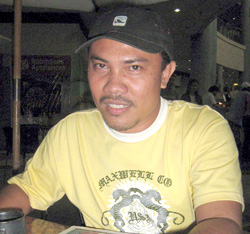
Visual artist and architect, Jomari Moleta
Jomari Moleta is one of the big names in the Ilonggo art scene. He is a visual artist and a practicing architect. His success happened amid difficulties that usually beset Ilonggo artists, but his consistency, perseverance and rare talent has got him to where he is now.
His works always present a new discovery. Well, the artist himself is like his art --- there is more to discover as The News Today finds out. To share ...
Kathy M. Villalon (KMV): At what age did you start holding art exhibits?
Jomari Moleta (JM): I was eight years old. I had a painting sold.
KMV: What did you do with the money?
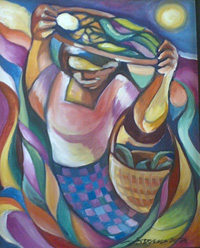
Manog-utan
JM: I bought a pair of shoes and a watch.
KMV: What was your memorable art competition experience?
JM: I was 10 years old then when I joined this art competition in SM. I did not expect to win because the other entries were really good. I felt discouraged. So, my mom and I left. As we were almost out of the venue, we heard that my entry won first prize. I got toys as prize.
KMV: What was the biggest art competition you've joined?
JM: Philip Morris Annual Art Competition and Epson Photo Contest. I was in the top 200 out of 5,000 entries in the latter, thus I was made finalist.
KMV: What's your favorite art subject?
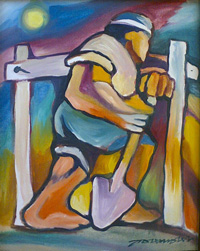
Manoglibod
JM: Social reality.
KMV: Do you use art to educate?
JM: Yes. Art is a potent tool to educate the masses. Our group, Busilak Artist Group, gives cultural inputs through our art. That way, we can be effective in educating the community. We talk of poverty, social injustice and the environment. I'm also a member of Ilonggos Concerned About The Environment (I-CARE).Through art, we shorten the information dissemination process.
KMV: Do you also conduct workshops?
JM: I conduct art seminars and lecture on school vacations. Our art group identifies communities where there are underprivileged children with potentials. We organize workshops for them. The last project we had was in Sigma, Capiz and fortunately, it was supported by the National Council for Culture and Arts.
KMV: What do you think of the art scene today?
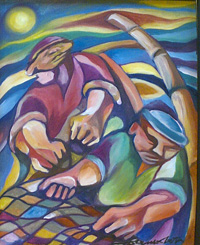
Lawudnon
JM: There are many promising artists but the acceptance by patrons is very laid back. Economics is also in play. The Ilonggos prioritize their basic needs instead of buying art. Also, there is a lack of venue. It's better if the local government can provide a venue for the artists. Then, there's the lack of cohesiveness among artists. During my term as president of our art group, we held monthly meetings and made effors to get endorsements from the government and funds for the arts month.
KMV: What would you like to see in Ilonggo art?
JM: For art to be interactive. Also, for the community to accept artistic endeavors in a such a way that they appreciate and buy artworks. By collecting art, you give value to the artist's work. In other countries, art is a treasure. Also, I hope artists would be more consistent.
KMV: In what way do you remain consistent?
JM: Every night, I draw. I do not stop making artworks and I'm happy because my works are bought. My collectors are mostly from outside of Iloilo.
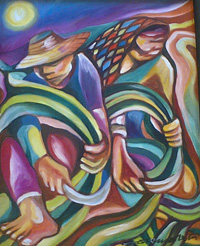
Ani
KMV: What's your preferred medium?
JM: Acrylic. It's good for the health and the environment.
KMV: What would you consider your best work so far?
JM: Dyipny. The painting depics the ambiance inside the jeepney after a long day's work. It portrays the different moods and emotions of Filipinos. The painting is rendered on oil on a 3 feet by six feet canvas. It's now in the the collection of a Canadian professor.
KMV: Any parting shot?
JM: We live in difficult times. How we survive as a nation depends solely on how we value our relationship as a community through collective efforts. My art is a reflection of how I perceive society. In the midst of harshness and realities of life there is indeed beauty. I believe that through our seasoned experience and constant learning we will prevail. As artist, my role is not only to dramatize splendor but to educate and reflect the social reality. Thus, provoke awareness to the audience.
